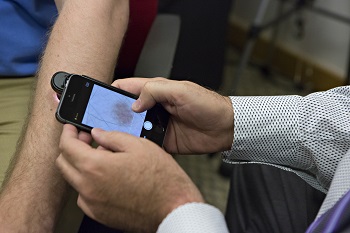
The idea sounds simple: Take a photo of a suspicious mole or lesion with your phone, run it through an embedded software program and find out within a few seconds if it is likely to be cancerous.
But it could make quick and inexpensive screening a reality for millions of people who lack access to medical specialists. A University of Houston professor created the app, called DermoScreen, which is now being evaluated for further testing at the University of Texas MD Anderson Cancer Center.
George Zouridakis, professor of engineering technology, has worked on the project since 2005, moving it to an application for a mobile phone after the iPhone became ubiquitous. The goal is to provide quick screening in rural areas or in the developing world, where specialty medical care generally isn’t available, he said.
Early testing found the device to be accurate about 85 percent of the time, Zouridakis said, similar to the accuracy rate for dermatologists and more accurate than primary care physicians. Patients would be referred for follow-up if the lesion were suspected to be cancerous.
In addition to a mobile phone, the technology uses a dermoscope attachment, a special magnifying lens, which costs about $500 and provides special illumination of the area being photographed.
DermoScreen could be commercialized soon; investors began expressing interest more than a year ago after a student team from the University’s Wolff Center for Entrepreneurship produced a business plan that won the $60,000 Grand Prize at the 2013 California Dreamin’ National Business Plan Competition and successfully pitched it in competitions around the country.
But Zouridakis, who has additional UH faculty appointments in electrical and computer engineering and in computer science, wanted to wait, both to pursue other diagnostic uses for the technology and to ensure that it was as accurate as possible.
The testing at MD Anderson is a step toward the latter goal, he said.
Dr. Ana Ciurea, assistant professor of dermatology at MD Anderson, said the project is in the early stages.
“Our research with Dr. Zouridakis on his promising iPhone app will focus on evaluating its use for risk assessment and as a screening tool for early detection of melanomas,” she said. “We are in early stages of planning and approval for this project, but such an application, if validated, has the potential for widespread use to ultimately improve patient care.”
Research into other uses of the technology continues. A $412,500 grant from the National Institutes of Health allowed testing of the device’s ability to screen for Buruli ulcer, a flesh-eating bacterial disease, in Africa.
A patent has been issued for the software and related technology used to diagnose melanoma, which develops when skin cells become abnormal and multiply, usually because of too much exposure to the sun.
Keith Lancaster, instructional assistant professor in the UH College of Technology, is working on the project with Zouridakis, helping to upgrade the software so it can handle the different diagnostic components. A longtime professional in the software industry before returning to academia to earn his Ph.D., Lancaster said his work involves “training” the software to allow it to make certain decisions after reading an image.
Zouridakis said the program is “an intersection” of engineering, physics, biology, computer science and medicine.
He received $50,000 in gap funding from the UH Division of Research to upgrade the software, part of a program the division instituted to help faculty inventors make the leap from an initial idea to commercialization.